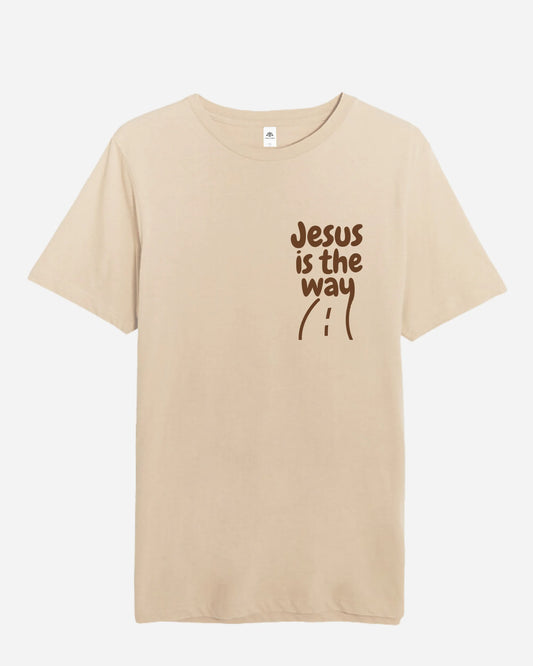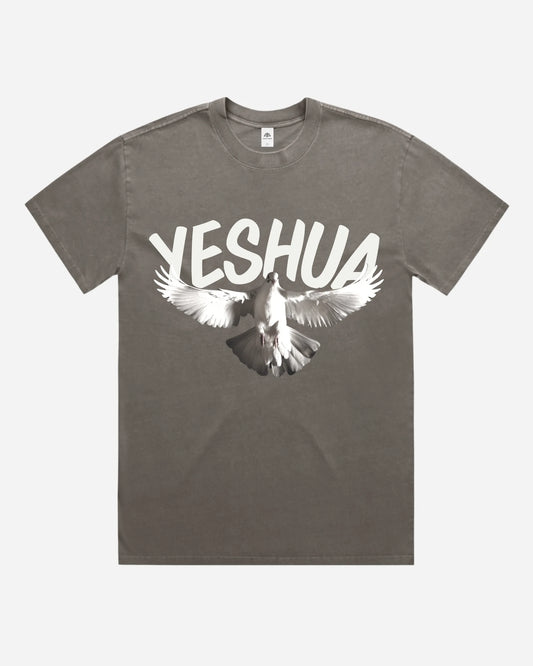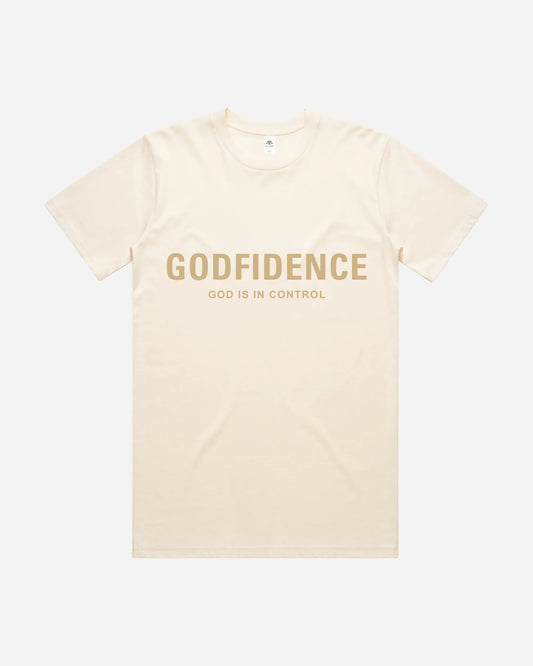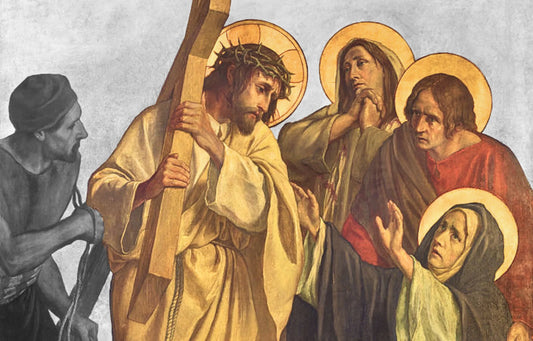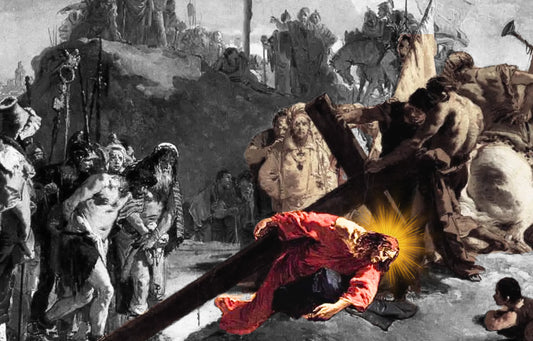Why does a medieval Crusader symbol still adorn modern churches, pilgrim medals, and even the flag of Georgia? First used in the 11th century, the Jerusalem Cross (also known as the Crusader’s Cross) has served as both a spiritual and military emblem for nearly a millennium. Originating with the Crusaders, it embodies Christ’s sacrifice and symbolizes the global reach of the Gospel. Explore its scriptural roots, historical journey, and enduring significance in Christianity today.
What Is the Cross of Jerusalem?
Structure and Components
The Jerusalem Cross features a large central Greek cross flanked by four smaller Greek crosses, one in each quadrant. This distinctive five-fold configuration sets it apart from other Christian crosses. It is often referred to as the "Crusader's Cross" or the "Five-Fold Cross", particularly in heraldic and ecclesiastical contexts.

Its balanced, geometric design expresses harmony and unity, with roots in the symmetrical Greek cross form where all arms are of equal length. This configuration appears in Byzantine Christian mosaics and carvings as early as the 8th century, though it reached its iconic status during the 11th-century Crusades.
Key Symbolism
- Central Cross: Symbolizes Christ as the center of the Christian faith.
- Four Smaller Crosses: Represent the Four Evangelists (Matthew, Mark, Luke, and John), or the four corners of the world—reflecting the universal mission of the Church (cf. Matthew 28:19; Acts 1:8).
- Five Wounds of Christ: A devotional interpretation tied to medieval mysticism, referring to the nails in Christ’s hands and feet and the spear in His side, as depicted in Passion-focused imagery of the Latin Patriarchate of Jerusalem.
Historical Origins and Crusader Use
Adoption by Godfrey of Bouillon (1099)
The cross gained widespread recognition during the First Crusade (1096–1099). Godfrey of Bouillon, appointed as Defender of the Holy Sepulchre after the Christian capture of Jerusalem in 1099, adopted the cross as the coat of arms of the newly founded Latin Kingdom of Jerusalem.

The cross appeared on shields, standards, seals, and coinage. Chronicler William of Tyre described its presence in royal insignia and liturgical processions. The design projected Christian authority and divine sanction in the contested Holy Land.
Crusader Symbolism
Beyond heraldry, the cross functioned as an eschatological and geopolitical statement. It embodied the Crusaders' belief that reclaiming Jerusalem was part of divine providence. As Riley-Smith notes, the symbol reflected Latin Christendom’s conviction that evangelization and holy war were twin arms of one mission (The First Crusaders, 1997).
Figures like John of Brienne, a key ruler in the Crusader states and King of Jerusalem from 1210 to 1225, further entrenched the symbol in Latin Christian identity. The cross was both banner and theological blueprint.
Franciscan Custody and Modern Usage

By 1333, the Franciscan Custody of the Holy Land received official sanction to guard Christian sites in Jerusalem. The Jerusalem Cross appears on the Custody’s seal and official buildings. Its use reflects the enduring mission of the Franciscans to protect sacred geography and promote peace.
According to The Franciscans in the Holy Land: 800 Years of Presence, the cross serves as a badge of guardianship and witness.
Biblical and Theological Meaning
Christ-Centered Theology
The cross’s visual design places Christ at the literal and theological center. It illustrates Colossians 1:17: “He is before all things, and in Him all things hold together.” This reflects patristic and medieval theology, particularly the idea of Christus Pantokrator—Christ as ruler of all.
The Five Wounds and Medieval Devotion
By the 13th century, the devotion to Christ’s Five Holy Wounds spread across Europe. The Jerusalem Cross became a visual tool for prayer and contemplation, particularly in the Franciscan and Dominican traditions. It appears in Pseudo-Bonaventure's Meditations on the Life of Christ and in manuscripts commissioned for female mystics like St. Gertrude the Great.
This imagery also appears in religious art across the Crusader states, reinforcing the link between physical suffering and divine kingship.
Evangelism and the Four Gospels
The smaller crosses evoke the Four Evangelists, forming a typological connection to the mission given in Acts 1:8—to spread the Gospel "to the ends of the earth." The layout can be read as a theological compass pointing outward, making the cross a map of missional theology.
This reading aligns with the Order of the Holy Sepulchre, which interprets the symbol as a visual representation of Christian outreach and care for the global Church.
Cultural and Liturgical Use Today
Pilgrimage and Identity
The Jerusalem Cross is a common keepsake for Christian pilgrims to the Holy Land, found on medallions, rosaries, and liturgical garments. Its use marks a physical and spiritual journey, linking modern pilgrims with medieval Crusaders.

The Equestrian Order of the Holy Sepulchre, reestablished by Pope Pius IX in 1847, continues to use the Jerusalem Cross prominently in its regalia. Members commit to defending the faith and supporting Christian communities in the Middle East.
Catholic, Orthodox, and Protestant Contexts
- Catholic: Papal travels to Jerusalem, including Pope John Paul II’s pilgrimage in 2000, featured the cross as part of official insignia.
- Orthodox: Embraced by Melkite Greek Catholics and the Greek Orthodox Patriarchate of Jerusalem, where the design often appears in gem-inlaid processional crosses.
- Protestant: The Lutheran Church of the Redeemer in Jerusalem, built in 1898 under Kaiser Wilhelm II, displays the Jerusalem Cross on its facade. The Episcopal Church Service Cross also reflects this tradition, symbolizing faith and service in mission.
Ecumenical Symbol
Used in gatherings of the World Council of Churches, the Jerusalem Cross has emerged as a symbol of ecumenical solidarity. It embodies a shared reverence for Jerusalem across denominational lines, serving as a theological bridge for interconfessional worship.
Lesser-Known Interpretations and Modern Perspectives
Sacred Geometry and Cosmology
The five-fold pattern aligns with ancient concepts of sacred space. The central cross represents the axis mundi, the cosmic center, while the four smaller crosses reflect cardinal points—north, south, east, west—mirroring the four rivers of Eden (Genesis 2:10–14).
According to P.D.A. Harvey’s research in Medieval Maps of the Holy Land, the Jerusalem Cross was used as a cartographic marker for sacred sites during the Middle Ages, reinforcing Jerusalem’s role as the spiritual center of the world.
Trinitarian Interpretation
Some theologians propose a Trinitarian reading: the central cross as the Son, surrounded by the Spirit-driven mission of the Church, all originating from the will of the Father. This interpretation appears in recent academic works on the visual theology of ecclesial mission, especially in Eastern Christianity.
Christian Zionism and Political Debate
While the Jerusalem Cross symbolizes spiritual mission, it has at times been co-opted for political purposes. In modern Christian Zionist movements, the cross sometimes appears alongside national or ideological messaging, raising concerns among theologians and historians.
Robert O. Smith, in More Desired than Our Owne Salvation (2013), cautions that the uncritical use of this sacred symbol risks reducing it to a partisan emblem, rather than a unifying spiritual image.
Distinct From Other Crosses
- Latin Cross: A longer vertical beam symbolizes the crucifixion of Jesus (widely used in Western Christianity).
- Greek Cross: All arms equal; often found in early Byzantine art.
- Maltese Cross: Eight-pointed and associated with the Knights Hospitaller.
The Jerusalem Cross stands apart in structure, density of meaning, and historical function. Unlike other Christian crosses, its five-fold design merges heraldic boldness with theological depth. This unique configuration has even influenced civic symbols—most notably, the national flag of Georgia (restored in 2004), which mirrors the cross-and-crosslet motif.
Conclusion
The Jerusalem Cross is far more than a relic of the Crusades. It is a multidimensional Christian symbol—rich in theological meaning, global in its mission, and deeply embedded in ecclesial history. From Godfrey of Bouillon (1099) to the Custody of the Holy Land, the five-fold cross has signified both suffering and resurrection, local presence and global witness.
As Jerusalem remains a crossroads of faiths and conflicts, this cross endures—not as a weapon of conquest, but as a compass pointing toward unity in Christ.


